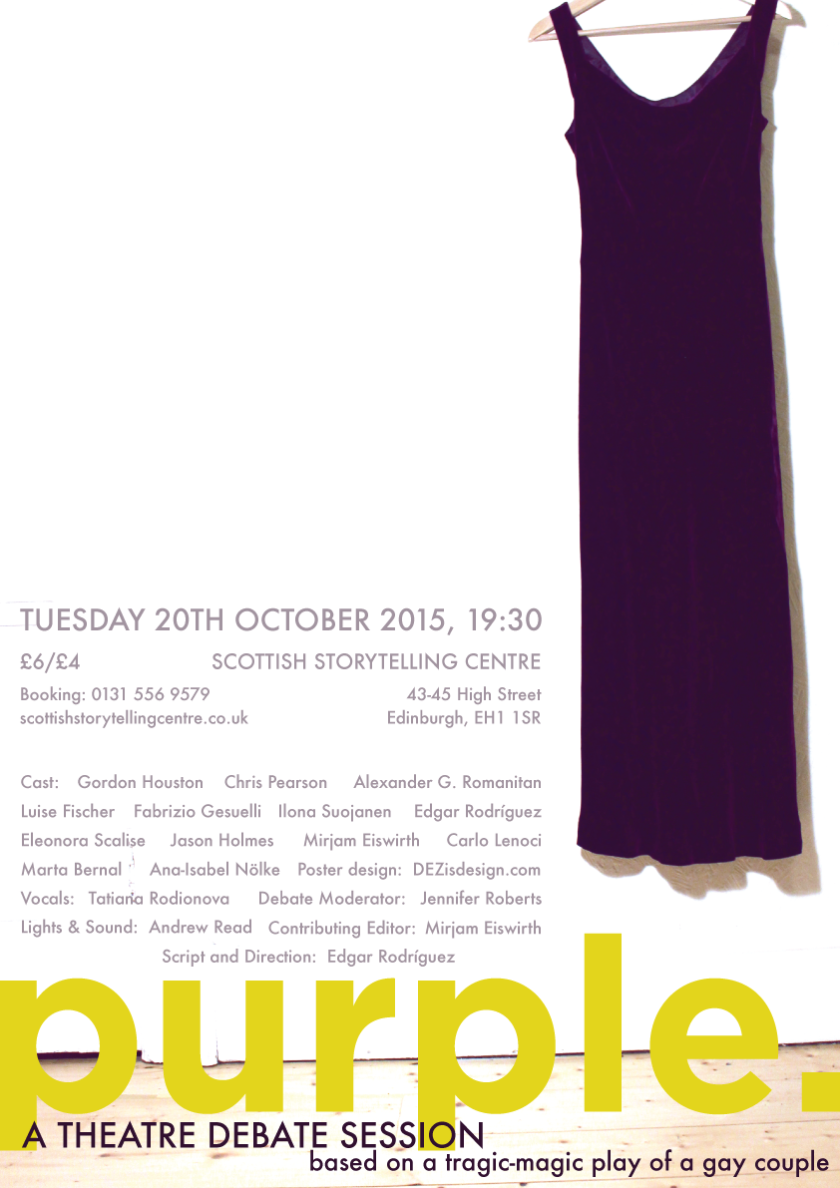Described by James as ‘a very ambitious play’ and by Samuel as ‘a play where every character does things wrong’. For me, as its writer, purple is a story about getting lost in life, finding my way through telling stories, and returning the Hope Diamond to Earth, where it belongs.
I’m Edgar Rodríguez, a doctoral researcher in the field of counselling and psychotherapy and I’m trying to understand aspects of identity and relationships between gay men. I’ve written and directed amateur theatre for 15 years in Mexico, but purple is my first original play written in English.
***
A cruel rejection which happened long ago has twisted a naïve love into a fearsome need for revenge. Julian is hurt by knowing that with his revenge he’ll hurt Stéphan, but for him there’s no other apparent solution to the affront he was object of.
They see love in each other’s eyes, they see beauty in each other, and they talk so proudly about each other. The term ‘lovers’ insufficiently describes the undisputed role they have in their respective lives and how special and meaningful they’re.
This theatrical fantasia challenges the boundaries of gender and identity. Here, youth is the highest currency, a Ferrari is a suitable present for a third anniversary, Stéphan finally makes sense of love in his fifties, and an act of forgiveness consumes nine lives.
***
“How would you embody on stage the essence of a time traveller?” –I asked.
“But we all are time travellers, aren’t we?” –Niall said.
Niall is a young actor from London, he auditioned for the role of Julian (the almost handsome but uncontestably glamorous guy who conquers Stéphan’s heart). During the audition we talked about how Julian manages to defy, not only the over-surveilled boundaries of gender but also the seemingly impenetrable boundaries of time. How does he do it? It’s not superpowers, one doesn’t need superpowers to travel in time. ‘We all have frozen time and repeated passages of our lives again and again’ –Niall told. And I agreed, I’ve done it several times. That’s actually how this play emerged; through my constant journeys to future, present, and past; by sewing rags of a broken relationship I’ve revisited until exhaustion.
Although it’s my third original play, it’s the most meaningful one, and the one in which I’ve dared to experiment and play with themes which are more personal, more intimate; themes I’m more engaged with, both intellectually and emotionally. Years have passed, years might have changed the way in which I see the pitiful end of an amazing relationship, but only I know how much I travelled in time, how much I went back to the days we spent together. And then, when trying to understand what happened to the love story I lived, purple was born and with its text it healed my tortuous narrative.
But it’s not only my personal background put there on the play; inspired by Murakami’s ‘Kafka on the shore’ and ‘Jordan the Edinburgh Library Cat’, I added some magic and created an endearing talking cat who guides Julian while finding his purpose in life. By being playful with the text I discovered that I wasn’t just elaborating my love story. Through the writing process I discovered I wasn’t travelling in time just to make sense of my past relationship; I was travelling to accomplish a more meaningful task. I realized Julian hadn’t come to this world just to fall in love, he had spent an eternity travelling because he needed to reach something beyond his personal interest. He was part of an event that comes for the restitution of some overriding principles. One of them is love, but in his case it wasn’t love towards a person.
***
Premiered this February during the Innovative Learning Week and sponsored by The University of Edinburgh, we had a captivating debate with our audience. We staged this play as a way to create a space for intellectual inquiring, involvement in innovative learning, reflecting about diversity, and engagement in alternative communication methods. At that point in time, some parts of the text felt absolutely right, I felt some other things needed to be developed. And now we’re here, staging it for the second time with a cast that is generously sponsoring me with their time, energy, and creative input to make this production an enjoyable one. Come along and talk with us about passion, love, gender, relationships, and the meanings we give to our lives.
http://www.tracscotland.org/scottish-storytelling-centre/centre-events/4097/purple
Suggested readings in connection to ‘purple’:
- Blando, J. A. (2001). “Twice Hidden: Older Gay and Lesbian Couples, Friends, and Intimacy.” Generations 25(2): 87-89.
Focuses on lesbian and gay men relationships in later life; how expressions of intimacy among older gay men and lesbians are perceived; dynamics underlying successful lesbian relationships; and stressors that affect intimacy among older lesbians and gay men.
- Heaphy, B. (2007). “Sexualities, Gender and Ageing: Resources and Social Change.” Current Sociology 55(2): 193-210.
The issue of sexuality is under-studied in the sociology of ageing. This article advocates placing sexuality at the centre of our analyses of ageing and later life in late modernity, by illustrating the issue of non-heterosexual ageing. The article employs personal narratives of lesbians and gay men aged between their fifties and eighties to demonstrate the importance of material, social and cultural resources in shaping their negotiations of ageing and later life.

